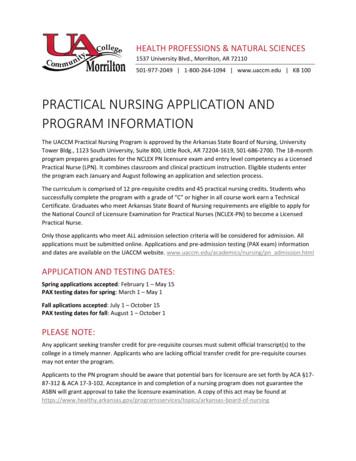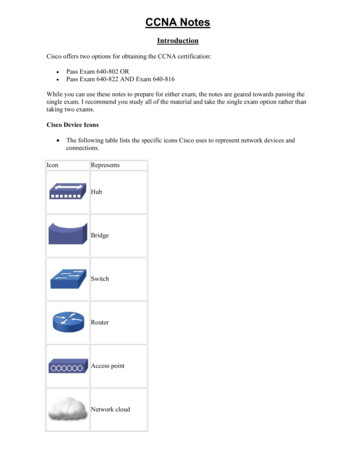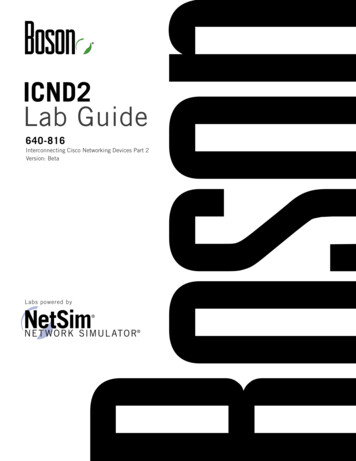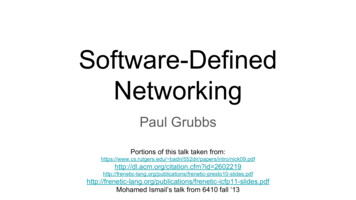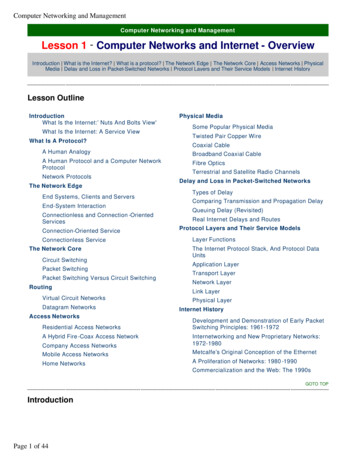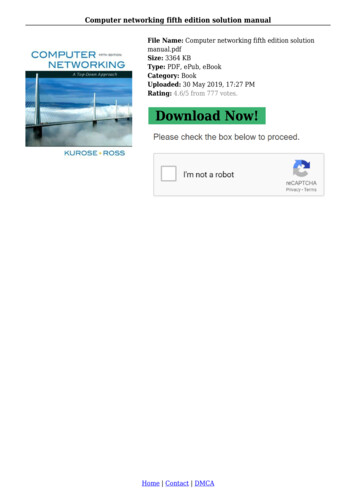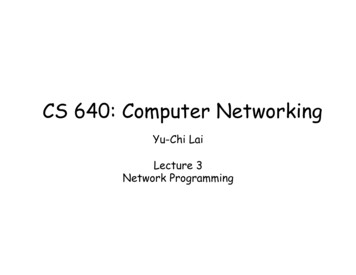
Transcription
CS 640: Computer NetworkingYu-Chi LaiLecture 3Network Programming
Topics Client-server modelSockets interfaceSocket primitivesExample code for echoclient andechoserver Debugging With GDB Programming Assignment 1 (MNS)
Client/server model Client asks (request) – server provides (response) Typically: single server - multiple clients The server does not need to know anything about theclient– even that it exists The client should always know something about theserver– at least where it is located1. Client sends request4. ClienthandlesresponseClientprocessServerprocess3. Server sends responseResource2. ServerhandlesrequestNote: clients and servers are processes running on hosts(can be the same or different hosts).
Internet Connections (TCP/IP) Address the machine on the network– By IP address Address the process– By the “port”-number The pair of IP-address port – makes up a “socket-address”Client socket address128.2.194.242:3479ClientServer socket address208.216.181.15:80Connection socket pair(128.2.194.242:3479, 208.216.181.15:80)Client host address128.2.194.242Note: 3479 is anephemeral port allocatedby the kernelServer(port 80)Server host address208.216.181.15Note: 80 is a well-known portassociated with Web servers
Clients Examples of client programs– Web browsers, ftp, telnet, ssh How does a client find the server?– The IP address in the server socket address identifies thehost– The (well-known) port in the server socket address identifiesthe service, and thus implicitly identifies the server processthat performs that service.– Examples of well known ports Port 7: Echo serverPort 23: Telnet serverPort 25: Mail serverPort 80: Web server
Using Ports to IdentifyServicesServer host 128.2.194.242Client hostClientService request for128.2.194.242:80(i.e., the Web server)Web server(port 80)KernelEcho server(port 7)ClientService request for128.2.194.242:7(i.e., the echo server)Web server(port 80)KernelEcho server(port 7)
Servers Servers are long-running processes (daemons).– Created at boot-time (typically) by the init process(process 1)– Run continuously until the machine is turned off. Each server waits for requests to arrive on awell-known port associated with a particularservice.See /etc/services for a– Port 7: echo servercomprehensive list of the– Port 23: telnet serverservices available on aLinux machine.– Port 25: mail server– Port 80: HTTP server Other applications should choose between 1024 and65535
Sockets as means for inter-processcommunication (IPC)application layerapplication layerClient ProcessInternetSockettransportlayer (TCP/UDP)OS networknetwork layer (IP)stacklink layer (e.g. ethernet)physical layerServer ProcessSocketInternetInternettransport layer (TCP/UDP)OS networknetwork layer (IP)stacklink layer (e.g. ethernet)physical layerThe interface that the OS provides to its networkingsubsystem
Sockets What is a socket?– To the kernel, a socket is an endpoint of communication.– To an application, a socket is a file descriptor that lets theapplication read/write from/to the network. Remember: All Unix I/O devices, including networks, aremodeled as files. Clients and servers communicate with each by readingfrom and writing to socket descriptors. The main distinction between regular file I/O andsocket I/O is how the application “opens” the socketdescriptors.
Socket Programming Cliches Network Byte Ordering–––––Network is big-endian, host may be big- or little-endianFunctions work on 16-bit (short) and 32-bit (long) valueshtons() / htonl() : convert host byte order to network byte orderntohs() / ntohl(): convert network byte order to host byte orderUse these to convert network addresses, ports, struct sockaddr in serveraddr;/* fill in serveraddr with an address */ /* Connect takes (struct sockaddr *) as its second argument */connect(clientfd, (struct sockaddr *) &serveraddr,sizeof(serveraddr)); Structure Casts– You will see a lot of ‘structure casts’
Socket primitives SOCKET: int socket(int domain, int type, intprotocol);––––domain : AF INET (IPv4 protocol)type : (SOCK DGRAM or SOCK STREAM )protocol : 0 (IPPROTO UDP or IPPROTO TCP)returned: socket descriptor (sockfd), -1 is an error BIND: int bind(int sockfd, struct sockaddr*my addr, int addrlen);– sockfd - socket descriptor (returned from socket())– my addr: socket address, struct sockaddr in is used– addrlen : sizeof(struct sockaddr)struct sockaddr in {unsigned short sin family;unsigned short sin port;struct in addr sin addr;unsigned charsin zero[8];};/*/*/*/*address family (always AF INET) */port num in network byte order */IP addr in network byte order */pad to sizeof(struct sockaddr) */
LISTEN: int listen(int sockfd, int backlog);– backlog: how many connections we want to queue ACCEPT: int accept(int sockfd, void *addr, int *addrlen);– addr: here the socket-address of the caller will be written– returned: a new socket descriptor (for the temporal socket) CONNECT: int connect(int sockfd, struct sockaddr*serv addr, int addrlen); //used by TCP client– parameters are same as for bind() SEND: int send(int sockfd, const void *msg, int len, intflags);––––msg: message you want to sendlen: length of the messageflags : 0returned: the number of bytes actually sent––––buf: buffer to receive the messagelen: length of the buffer (“don’t give me more!”)flags : 0returned: the number of bytes received RECEIVE: int recv(int sockfd, void *buf, int len, unsigned intflags);
SEND (DGRAM-style): int sendto(int sockfd, const void *msg,int len, int flags, const struct sockaddr *to, int tolen);––––––msg: message you want to sendlen: length of the messageflags : 0to: socket address of the remote processtolen: sizeof(struct sockaddr)returned: the number of bytes actually sent RECEIVE (DGRAM-style): int recvfrom(int sockfd, void *buf,int len, unsigned int flags, struct sockaddr *from, int*fromlen);––––––buf: buffer to receive the messagelen: length of the buffer (“don’t give me more!”)from: socket address of the process that sent the datafromlen: sizeof(struct sockaddr)flags : 0returned: the number of bytes received CLOSE: close (socketfd);
Client server: connectionlessCREATEBINDSENDRECEIVESENDCLOSE
Client server: P rrent server
Echo Client-Server
#include’s#include stdio.h /* for printf() and fprintf() */#include sys/socket.h /* for socket(), connect(),sendto(), and recvfrom() */#include arpa/inet.h /* for sockaddr in andinet addr() */#include stdlib.h /* for atoi() and exit() */#include string.h /* for memset() */#include unistd.h /* for close() */#include netdb.h /* Transform the ip addressstring to real uint 32 */#define ECHOMAX 255/* Longest string to echo */
EchoClient.cpp -variable declarationsint main(int argc, char *argv[]){int sock;/* Socket descriptor */struct sockaddr in echoServAddr; /* Echo server address */struct sockaddr in fromAddr; /* Source address of echo */unsigned short echoServPort 2000; /* Echo server port */unsigned int fromSize;/* address size for recvfrom() */char *servIP “172.24.23.4”; /* IP address of server */char *echoString “I hope this works”; /* String to send toecho server */char echoBuffer[ECHOMAX 1];/* Buffer for receivingechoed string */int echoStringLen;/* Length of string to echo */int respStringLen;/* Length of received response */
EchoClient.c - creating the socket/* Create a datagram/UDP socket anderror check */sock socket(AF INET, SOCK DGRAM,0);if(sock 0){printf("Socket open error\n");exit(1);}
EchoClient.cpp – sending/* Construct the server address structure */memset(&echoServAddr, 0, sizeof(echoServAddr)); /* Zero outstructure */echoServAddr.sin family AF INET; /* Internet addr family */inet pton(AF INET, servIP, &echoServAddr.sin addr); /* Server IPaddress */echoServAddr.sin port htons(echoServPort); /* Server port *//* Send the string to the server */echoStringLen strlen(echoString);sendto(sock, echoString, echoStringLen, 0, (struct sockaddr *)&echoServAddr, sizeof(echoServAddr);
EchoClient.cpp – receiving and printing/* Recv a response */fromSize sizeof(fromAddr);recvfrom(sock, echoBuffer, ECHOMAX, 0, (struct sockaddr *)&fromAddr, &fromSize);/* Error checks like packet is received from the same server*/ /* null-terminate the received data */echoBuffer[echoStringLen] '\0';printf("Received: %s\n", echoBuffer); /* Print the echoed arg */close(sock);exit(0);} /* end of main () */
EchoServer.cpp – creating socketint main(int argc, char *argv[]){int sock;/* Socket */struct sockaddr in echoServAddr; /* Local address */struct sockaddr in echoClntAddr; /* Client address */unsigned int cliAddrLen;/* Length of incoming message */char echoBuffer[ECHOMAX];/* Buffer for echo string */unsigned short echoServPort 2000; /* Server port */int recvMsgSize;/* Size of received message *//* Create socket for sending/receiving datagrams */sock socket(AF INET, SOCK DGRAM, 0);if(sock 0){}printf("Socket open error\n");exit(1);
EchoServer.cpp – binding/* Construct local address structure*/memset(&echoServAddr, 0, sizeof(echoServAddr)); /* Zero out structure*/echoServAddr.sin family AF INET; /* Internet address family */echoServAddr.sin addr.s addr htonl(INADDR ANY);echoServAddr.sin port htons((uint16 t) echoServPort); /* Local port *//* Bind to the local address */int error test bind(sock, (struct sockaddr *) &echoServAddr,sizeof(echoServAddr));if(error test 0){printf("Binding error\n");exit(1);}
EchoServer.cpp – receiving and echoingfor (;;) /* Run forever */{cliAddrLen sizeof(echoClntAddr);/* Block until receive message from a client */recvMsgSize recvfrom(sock, echoBuffer, ECHOMAX, 0,(struct sockaddr *) &echoClntAddr, &cliAddrLen);printf("Handling client %s\n", inet ntoa(echoClntAddr.sin addr));}/* Send received datagram back to the client */sendto(sock, echoBuffer, recvMsgSize, 0,(struct sockaddr *) &echoClntAddr, sizeof(echoClntAddr);} /* end of main () */Error handling is must
Socket Programming Help man is your friend– man accept– man sendto– Etc. The manual page will tell you:– What #include directives you need at thetop of your source code– The type of each argument– The possible return values– The possible errors (in errno)
Debugging with gdb Prepare program for debugging– Compile with “-g” (keep full symbol table)– Don’t use compiler optimization (“-O”, “–O2”, ) Two main ways to run gdb– On program directly gdb progname Once gdb is executing we can execute the program with:– run args– On a core (post-mortem) gdb progname core Useful for examining program state at the point of crash Extensive in-program documentation exists– help (or help topic or help command )
More information Socket programming– W. Richard Stevens, UNIX Network Programming– Infinite number of online resources– .html GDB– Official GDB homepage: http://www.gnu.org/software/gdb/gdb.html– GDB primer: http://www.cs.pitt.edu/ mosse/gdb-note.html
Project Partners If you don’t have a partner– Stay back after class Now – Overview of PA 1
The interface that the OS provides to its networking subsystem application layer transport layer (TCP/UDP) network layer (IP) link layer (e.g. ethernet) physical layer OS network stack Sockets as means for inter-process communication (IPC) Client Process Server Process Socket OS network stack Socket Internet Internet Internet
